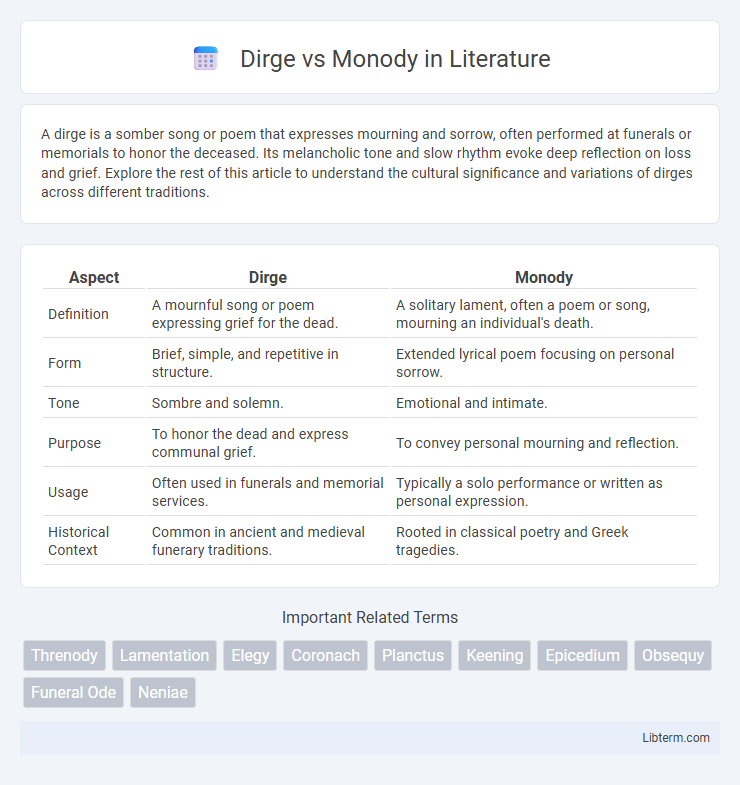A dirge is a somber song or poem that expresses mourning and sorrow, often performed at funerals or memorials to honor the deceased. Its melancholic tone and slow rhythm evoke deep reflection on loss and grief. Explore the rest of this article to understand the cultural significance and variations of dirges across different traditions.
Table of Comparison
| Aspect | Dirge | Monody |
|---|---|---|
| Definition | A mournful song or poem expressing grief for the dead. | A solitary lament, often a poem or song, mourning an individual's death. |
| Form | Brief, simple, and repetitive in structure. | Extended lyrical poem focusing on personal sorrow. |
| Tone | Sombre and solemn. | Emotional and intimate. |
| Purpose | To honor the dead and express communal grief. | To convey personal mourning and reflection. |
| Usage | Often used in funerals and memorial services. | Typically a solo performance or written as personal expression. |
| Historical Context | Common in ancient and medieval funerary traditions. | Rooted in classical poetry and Greek tragedies. |
Introduction to Dirge and Monody
Dirge and monody both serve as traditional musical forms expressing sorrow and mourning, yet they differ in style and purpose. A dirge is a somber, mournful song typically performed at funerals to honor the deceased and convey collective grief. Monody, originating from ancient Greek and Renaissance music, is a solo lament expressing personal sorrow with a focus on vocal expression and emotional depth.
Definitions: What is a Dirge?
A dirge is a somber, mournful song or poem expressing grief, typically performed at funerals or memorial services to honor the deceased. It is characterized by its slow, solemn tempo and melancholic tone, designed to evoke sorrow and reflection. Unlike a general elegy, a dirge specifically serves a ritualistic role in mourning and often accompanies burial rites.
Understanding Monody: Meaning and Origins
Monody is a solo vocal lament expressing personal grief, originating in ancient Greek tragedy where it conveyed individual sorrow distinct from communal mourning chants like dirges. Unlike dirges, which are collective funeral songs performed by groups to honor the deceased, monodies emphasize intimate emotional expression through a singular melodic voice. This distinction highlights monody's role in exploring personal mourning within literary and musical traditions, influencing later Western odic and operatic forms.
Historical Contexts of Dirge and Monody
Dirges originated in ancient funeral rites, commonly featured in Greek and Roman ceremonies as somber lamentations performed to honor the dead and facilitate mourning. Monody emerged during the early Baroque period as a vocal style emphasizing solo emotional expression, evolving from the Greek tradition of solo lament and influencing early opera and sacred music. Both forms reflect cultural attitudes toward death and mourning, with dirges serving communal grief rituals while monodies highlight individual sorrow through distinct musical structures.
Literary Structure: Dirge vs Monody
Dirges typically follow a somber, repetitive structure with a mournful refrain that emphasizes communal grieving and ritualistic lamentation. Monodies are characterized by an individualized, expressive form that centers on a single voice or persona conveying personal sorrow and reflection. The structural contrast highlights the dirge's collective mourning versus the monody's intimate, lyrical introspection.
Emotional Tone and Purpose
A dirge conveys a solemn, mournful emotional tone emphasizing grief and loss, often performed at funerals to honor the deceased and express collective sorrow. A monody shares a similar sorrowful mood but focuses more on personal lamentation and intimate reflection, typically presented as a solo vocal piece. Both serve to evoke deep emotional responses, but the dirge is communal and ritualistic, while the monody is individual and introspective.
Notable Examples in Literature and Music
Dirges, often characterized by their somber, lamenting tone, appear prominently in literature like Edgar Allan Poe's "The Raven" and musical compositions such as Giuseppe Verdi's "Requiem." Monodies, featuring a single voice or melodic line typically expressing personal grief, are exemplified in Greek ancient poetry by solo laments like those by Sappho and in music through Henry Purcell's "Dido's Lament." Notable distinctions lie in the dirge's communal mourning context versus the monody's individual emotional expression.
Usage in Modern Times
A dirge is typically used in modern times as a somber musical or poetic expression at funerals or memorial services, emphasizing mourning and loss. In contrast, a monody often refers to a solo lament sung in contemporary classical music or theatrical performances, highlighting personal grief with emotional intensity. Both forms retain their cultural significance but diverge in purpose and setting, with dirges focusing on communal grieving and monodies on individual expression.
Key Differences: Dirge vs Monody
A dirge is a somber, mournful song specifically composed for funerals or memorial services, highlighting collective grief through slow, solemn melodies. In contrast, a monody is a lyrical, solo vocal piece expressing personal lament or sorrow, often featuring a single melodic line with minimal accompaniment. The key difference lies in dirges being communal expressions of mourning, while monodies emphasize individual emotional reflection.
Conclusion: Choosing the Right Form for Mourning
Dirges and monodies both serve as powerful expressions of grief, yet their distinct characteristics guide the choice for mourning rituals. Dirges, with their solemn, communal tone, are suited for formal ceremonies seeking collective sorrow, while monodies, featuring personal lamentation and emotional depth, fit intimate or individual mourning. Selecting between them depends on the desired atmosphere and cultural context of the bereavement process.
Dirge Infographic

 libterm.com
libterm.com